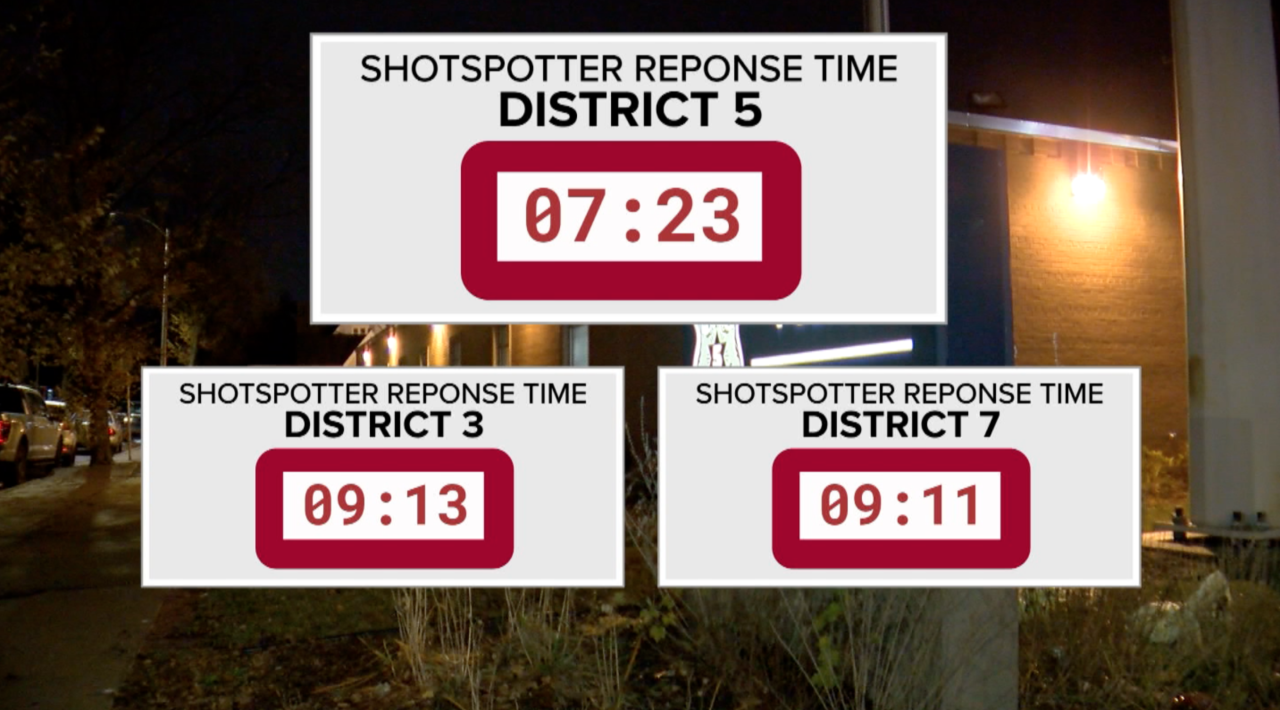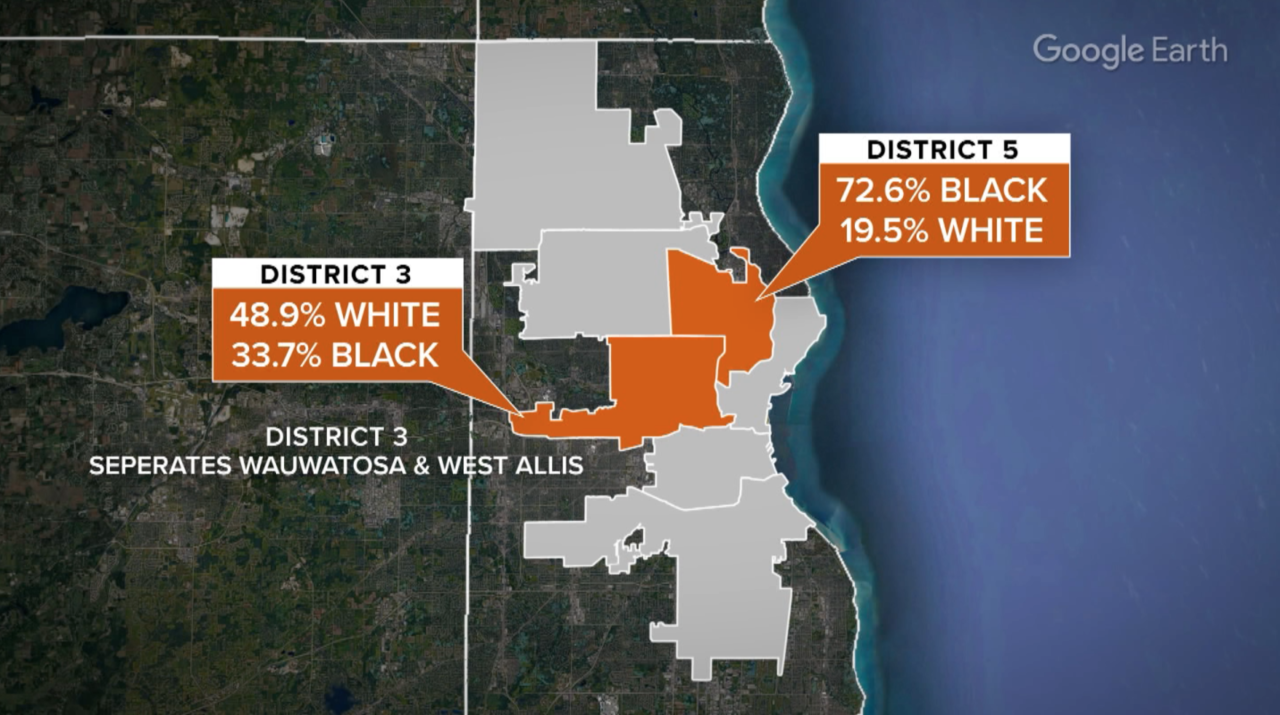MILWAUKEE — Despite faster response times, a Milwaukee Police Department ShotSpotter team is located in the part of Milwaukee with the highest percentage of African American residents, despite having fewer alerts than another more diverse district.
The I-Team first approached MPD last year about the high number of reports of guns drawn by police at District 5. Police Chief Jeffrey Norman pointed to the fact that District 5 had a ShotSpotter team as the reason.
In essence, that team is more likely to arrive on an active situation and would be more likely to need to have their weapons drawn. ShotSpotter is a technology used to detect gunshots as they happen, using microphone sensors scattered throughout the city. Those sounds are transmitted to the closest police district so its officers can respond.
It has proven effective. District 5 routinely recovers more guns than any other district.
It also responds much faster to ShotSpotter alerts. District 5’s ShotSpotter Team averaged seven minutes and 23 seconds from alert to response. Districts 3 and 7, which handle a similar number of calls, average nine minutes and 13 seconds and nine minutes and eleven seconds respectively.
“They get there quickly and they want to make sure the shooting stops and no one is getting hurt,” Inspector David Feldmeier said of District 5’s ShotSpotter Team. “If an assault is going on, if there is continuing firing, it stops it quicker. If there are people hurt, it’s two minutes quicker to get them aid.”

Feldmeier has held a wide variety of positions during his time with the Milwaukee Police Department. He was even a part of the first pseudo-ShotSpotter Team, as a member of the Neighborhood Task Force. Essentially, members of the Tactical Enforcement Unit would respond to the ShotSpotter calls in a similar fashion to the current ShotSpotter team.
He formerly oversaw District 5 as its Captain. He found the ShotSpotter Team made sense and was productive so he signed off on keeping it.
“When I got there and took over, I analyzed it and said this is a good idea,” Feldmeier said. “We should keep this going. [ShotSpotter calls] take up a lot of time. Many times, there’s not really anything for us to find, depending on the circumstances, but we do respond to a lot of ShotSpotter calls where there is someone there, whether an individual shooting or someone who has been hit by gunfire.”
Feldmeier is understating how often they respond to ShotSpotter Alerts. Districtwide in 2021, Officers responded to 98.8 percent of all ShotSpotter calls in an average of eight minutes and 30 seconds.
“The quicker response times provide the ability to preserve evidence, so it helps with investigations,” Feldmeier said. “It helps with general safety. We’re able to collect casings, talk to witnesses we find right on the scene who, maybe two minutes later, might have thought, 'I’m not going to stick around and say what I saw.' It brings a certain confidence from the citizenry, from the neighbors.”
Feldemeier says MPD follows a data driven approach to its strategies but it’s ultimately the decision for the leaders at each individual district.
“We hope those other districts might implement something similar,” Feldmeier said. “We’re a team. We try to get consistency throughout the districts. If something is working in a particular district, we would like the other districts to try it. It doesn’t necessarily mean that is what is going to work but it gives a blueprint of, hey, this might work.”

While the ShotSpotter team has been successful in responding quickly and recovering guns, District 5 did not receive the most ShotSpotter Alerts in the last year. That distinction goes to District 3, which had 5,325 calls compared to District 5’s 4,431.

The I-Team originally questioned MPD about the high number of police weapons drawn by officers at District 5 because the area it patrols has the highest percentage of African Americans. While the ShotSpotter team explained the reason for more weapons being drawn, the data for ShotSpotter Alerts leads to a belief District 3 should also have a ShotSpotter team. District 3’s population is much more diverse. Health Compass Milwaukee’s data shows the ZIP Codes District 3 covers are 48.9 percent white and 33.7 percent Black. By comparison, residents in District 5 are 19.5 percent white and 72.6 percent Black.
“We’re always concerned of how it looks to the greater community,” Feldmeier said. “We’re always aware of the demographics of the different areas of the city that we patrol. We try to employ, as best we can, a data driven approach showing where the need is, the greatest need for protection.”
The I-Team questioned Feldmeier on areas of “greatest need,” pointing to the data showing District 3 had 894 more ShotSpotter alerts than District 5 last year.
“That’s going to be up to that District and their analysis of what they find and where they use their personnel,” Feldmeier said.
“It tells us that Black neighborhoods are targeted more than white neighborhoods,” Deontae Robinson, Lead Ambassador at Black Leaders Organizing Communities (BLOC) said.
Robinson shared his story with the I-Team last year, of police officers pulling a gun on him multiple times in his life. Robinson has nothing more than traffic violations on his record.
“They said I was suspicious or something like that,” Robinson said.
His interactions with police are what fuel his mistrust and skepticism in law enforcement. He says he questions every tactic police use and this data, he says, reinforces his feelings that police target Black communities.
“They’re trying to say, we want y’all,” Robinson said. “We want to lock all y’all up. That’s why [53206] is the most incarcerated ZIP Code anyway. We’re paying a lot of taxpayer dollars and you’re using it to bring in another system to lock us up even more. Give that back. Put it back in the community and let us do the right thing.”
“I think they should be aware of it,” Feldmeier said. “Concerned? That’s up to each individual. I can tell you, we’ve gone to great lengths to provide the most professional, unbiased service we can. As the District Captain at District 5, when I go to these crime and safety meetings, they’re asking us for more. We want more. We want to see you guys more. We want to see more of the good work you do. We take a measured approach. We educate our citizenry and we employ upon our officers to be as professional as can be.”

Feldmeier points to two reasons why District 3 may have more ShotSpotter Alerts than District 5. For starters, according to Feldmeier, District 3 has more ShotSpotter sensors than District 5. He also points to the central location of District 3. In theory, District 3 can respond to fringe calls from Districts 2, 5 and 7. District 5 doesn’t have that same ability.
But overall, Feldmeier says discussions are ongoing for expanding the use of ShotSpotter programs.
“It depends on the type of personnel they have,” Feldmeier said. “There are discussions on personnel and moving officers to where the need is most. We also are looking at options to expand ShotSpotter programs. Those are all in discussion. They cost money and there are other challenges that come with that. Nothing is off the table.”



